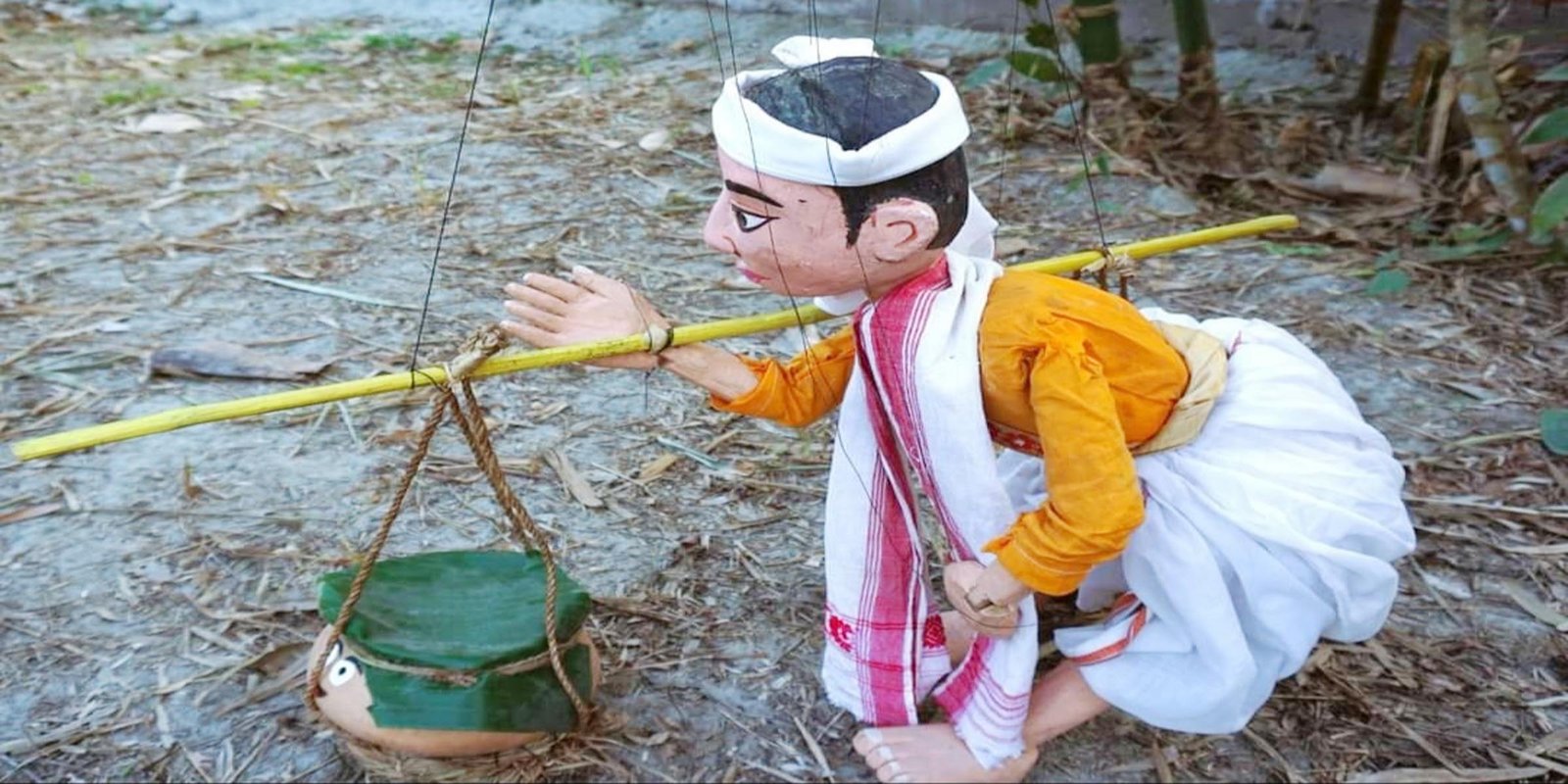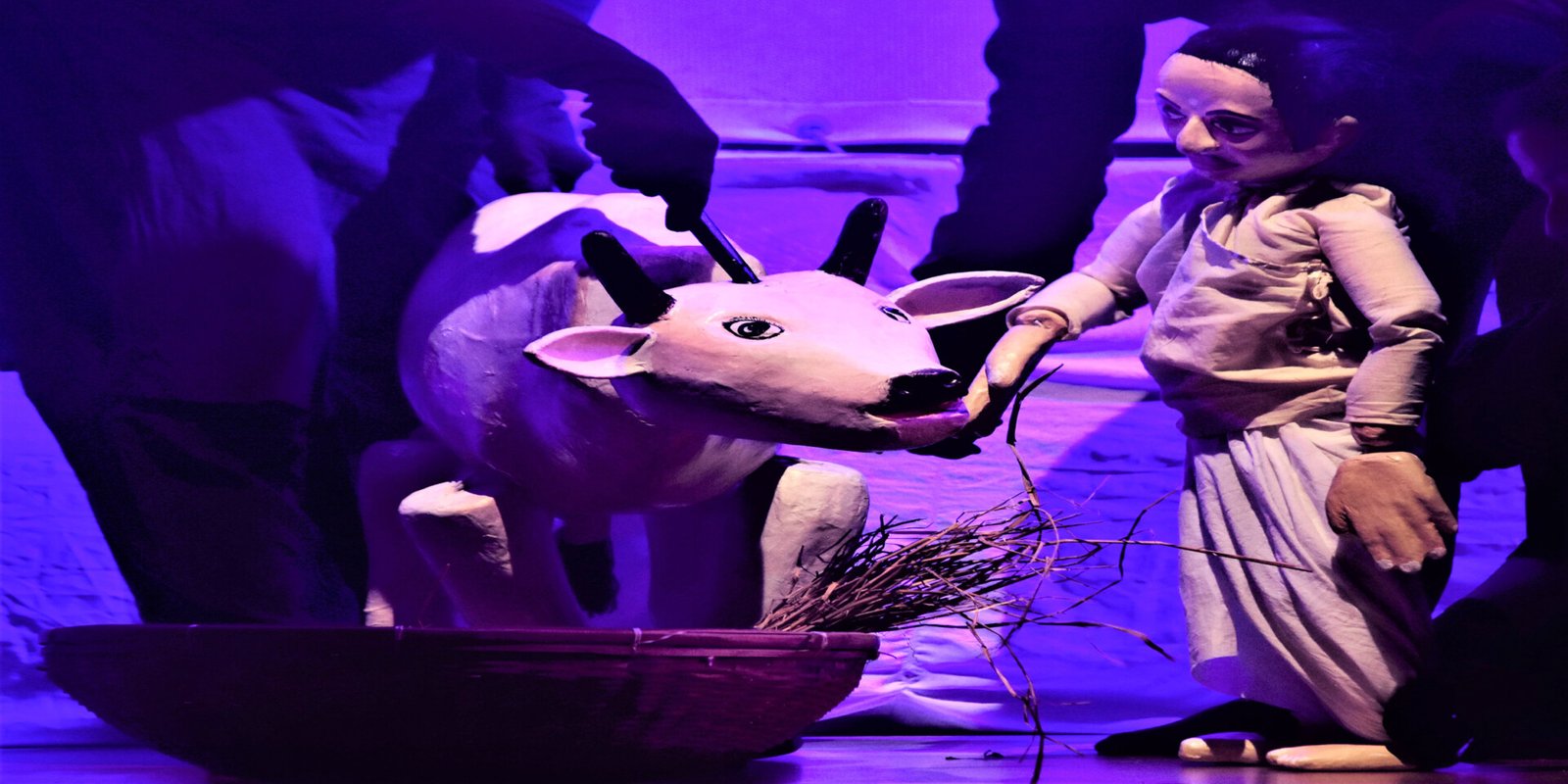By: Simanta Sarma
The use of puppetry in art can be traced back to ancient Greece. Although the discovery of puppetry in the burial sites of ancient Mesopotamia with artifacts like ivory and clay puppets suggests that the sophisticated Greek civilization might have adopted it, the development of puppetry is believed to have originated in ancient Greece. Puppetry has played a significant role in the cultural evolution of various societies in Africa, particularly prevalent in the ancient civilizations of North and South Africa.
The origins of Indian puppetry are often linked to the theatre traditions dating back to around 500 BCE. The excavation sites of Harappa and Mohenjo-Daro provide evidence of puppetry with clay models found there. Philosophically, puppetry in Indian culture is reflected in the Bhagavad Gita, where the cosmic dance of Lord Shiva is compared to a puppet show. Throughout the Indian subcontinent, puppetry has been a source of inspiration for folklore, mythology, and local legends.
There are four main types of puppets: string puppets, rod puppets, shadow puppets, and glove puppets. The names of puppets vary across the states of India. In Assam, the existence of puppetry is not clearly evident in ancient times. However, written evidence in the Kalika Purana from the 9th century AD suggests the strong presence and reliability of puppetry in Assam. The term “Panchalika Vihar” used in the Kalika Purana likely indicates the existence of puppetry in those times, with “Panchali” meaning puppet and “Panchalika Vihar” referring to a particular form of puppetry. Puppetry is mentioned in the Assamese Bhagavata as well. The use of wooden puppets and shadow puppets is implied.
In Assamese culture, puppetry holds significant importance. Various forms of puppetry are performed in different contexts. Through these art forms, puppetry has evolved and thrived both as a traditional and contemporary cultural expression. Despite the decreasing significance in the modern technological era, the efforts and struggles of puppetry artists have helped it survive and thrive globally, making it an integral part of the world’s cultural heritage.
The art of puppetry is one of the ancient traditional folk arts that has always been an integral part of the cultural and religious philosophy and practices of the northeastern region of India. Perhaps, it is in the early ages that this form of art, possibly initiated by the ‘Puthala Natok’ (puppet drama) name, gave birth to the movement of anthropomorphic representations by human figures. Over time, it has evolved into a comprehensive form incorporating elements from various arts. This art form encompasses two main elements: puppet making and presentation.
In puppet making, stories from Indian mythologies are often depicted with characters crafted according to the narratives. The presentation involves storytelling, singing, dancing, and skillful manipulation of puppets to create a visually captivating performance. The performance area, usually a stage in rural settings, is adorned with vibrant colours, and puppeteers use their hands, fingers, and sometimes even their feet to control the movements of the puppets, adding a dynamic and lively aspect to the scenes.
Moreover, the puppeteer, through the use of hand gestures, facial expressions, and body language, conveys emotions, narrates stories, sings songs, and engages the audience. This art form plays a significant role in the socio-cultural exchange and communication in rural India, where traditional values, beliefs, and practices form the foundation of knowledge and interaction. It serves as a means of information exchange and communication in rural areas, contributing to the development of indigenous systems of knowledge and communication.
In addition to being a source of entertainment, puppetry in India serves as a powerful medium for conveying information, knowledge, and messages. It goes beyond mere entertainment and becomes an inspiring and informative communication tool. Through the years, it has transformed into a powerful medium for information exchange and communication. It dispels superstitions prevalent in rural areas, educates on various subjects, and, in particular, plays a crucial role in the development of information exchange and communication networks in rural India.
India, with its complex social structure, is a diverse country where people from various castes, classes, religions, and ethnicities coexist. Through puppetry, it has significantly influenced the art forms of local communities, reflecting the rich cultural diversity of the country. It not only provides entertainment but also inspires and conveys meaningful messages. Puppetry in India is not just a form of entertainment; it is a medium that connects generations.
The traditional puppetry of India, particularly the string puppetry and shadow puppetry, has played an essential role in empowering women. According to studies, traditional puppetry provided women with an active role, breaking the barriers of limited participation. In Kerala, the ‘Tholpavakuthu’ form of traditional shadow puppetry, led by Ramachandra Pulavar, has provided women with the opportunity to actively participate and contribute to the art form. Women have been involved in creating the puppet’s body, designing and dressing the puppets, using natural materials like clay, fabric, coconut husk, and bamboo.
The use of natural materials, such as clay, fabric, leaves, and bamboo, for creating puppets is significant in this traditional art form. Women play an active role in preparing materials like seeds and charcoal, weaving cloth, and using natural colors to create intricate designs. The craft of puppetry is an integral part of India’s traditional folk art, thriving in many regions of the country, as oral traditions pass down the art from one generation to another. Particularly in rural areas, the exchange of information and communication through oral traditions plays a crucial role in development.
The traditional puppetry of India, with its elaborate designs and vibrant colors, has become a form of not just entertainment but also a medium for communication. It is a continuous form of communication that transcends generations, preserving traditional art in its timeless form. Puppetry is not just a form of entertainment; it is a living art that continues to be relevant in contemporary times, serving as a bridge between tradition and modernity.”
In this art form, the practice of preserving the traditional female sculptures was maintained. The reasons for preserving these sculptures from this art form are partially related to customs and traditions, as well as their association with rituals and seasonal cycles. Female sculptures, representing deities and celestial beings, play a representative role according to popular belief, and they are considered sacred entities.
The sculptures are counted as holy, and women are not allowed to touch or participate in the creation or modification of these sacred idols. Despite not being governed by any formal rules, such practices are deeply rooted in cultural beliefs.
In earlier times, women were not allowed to venture outside their homes. Movement outside the household was restricted. Women were mainly engaged in domestic work, and their activities were directed within the confines of their homes. In Kerala and other regions of India, traditional artisans, primarily men, perform rituals and ceremonies, and women are not allowed to participate. The puja room in the house is considered sacred, and the cleanliness of the area is of utmost importance. Women are not allowed to enter the puja room during certain times.
The traditional belief system in Kerala has led to the exclusion of women from certain roles, such as serving as priests in temples. Only men are permitted to perform such roles. The concept of a female priest in a temple, especially for rituals related to female deities, is not accepted in the traditional framework. However, in recent times, there has been a shift in this perception, and women are taking on diverse roles, including those traditionally reserved for men. Ramachandran Pulavar emphasizes the contemporary significance of female puppetry in India. Modern women engaged in puppetry theatre have shown a keen interest in reviving and promoting traditional puppetry. Women in contemporary attire actively contribute to the preservation and promotion of puppetry as an art form. They use puppetry not only for entertainment but also as a means of addressing important social issues in India.
In today’s context, female artists are actively participating in puppetry performances, receiving training, and contributing to the development and dissemination of puppetry as an art form. Ramachandran Pulavar’s wife and daughter are not only involved in performances but also contribute to the creation of puppetry. The traditional practices of puppetry are being followed even in this contemporary context, and women are playing a vital role in the resurgence of puppetry.
Overall, female artists in puppetry are contributing significantly to the contemporary revival, sustainable development, and widespread recognition of puppetry as an art form in India. They are breaking barriers and challenging societal norms, making puppetry a powerful medium for storytelling and expression.
Born in Lucknow in 1934, Lilavati M Kabi has contributed a lot to puppetry. She has earned a reputation for performing puppet dance in India and abroad. He received the Sangeet Natak Akademi Award of the Government of India in 2013 for his active role in puppet dance and contribution to the society. Many women have received awards for puppet dance at national and international levels. The role of women in puppet dance is unique in different states of India. She is actively earning her living by doing puppet dancing in Kerala, Rajasthan, Calcutta, Assam and other states. Shubha Saxena successfully worked in the Department of Puppetry at the Sangeet Natak Akademi, Government of India. In the case of Assam, women are involved in puppet dance.
Women are involved with puppets in many groups in Assam. Narayan Deka of Assam Puppet Theatre, Giridhar Senapati of Navaratna Puppet Theater and Sagarika Puppet Theatre’s wife Manoranjan Roy are deeply involved in puppet dance. He has also made, directed and voiced the puppets. Puppet dancer Archana Talukdar is an employee of the Directorate of Cultural Affairs, Government of Assam. Binita Devi of Guwahati, Assam has been promoting puppet dance through Surojit Academy. He has received National Research Tagore Scholarship, Junior Fellowship, Senior Scholarship from the Ministry of Culture, Government of India and is conducting research on puppet dance at Mahapurush Srimanta Sankardev Viswavidyalay. Government programs like NCERT, CCRT, Vigyan Prasar, ASTEC, SCERT etc. have been providing training to school teachers on how to easily acquire knowledge through puppet dance in education. In addition, she has promoted the importance of puppet dance in education by conducting workshops and puppet dance performances in various universities and schools in India. Binita Devi has earned a reputation for performing puppet dance in cultural stages in various states under the Government of India. There are many women who are successfully doing puppet dance in Assam. It is a good sign for the folk art of Assam that many women of the new generation are learning puppet dance and working on the subject.
In conclusion, puppetry has become a significant form of cultural expression, connecting traditional and modern elements. Women, as puppetry artists, have played a crucial role in shaping the cultural landscape of Assam. The contemporary landscape of art and culture is dynamic, with a focus on research, education, social causes, economic aspects, campaigns, and, ultimately, entertainment. (The author is an Assistant Professor, Sualkuchi Budaram Madhab Satradhikar College, Sualkuchi)







